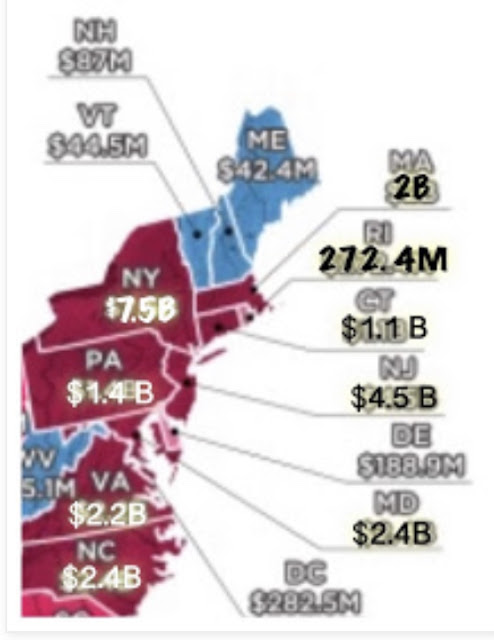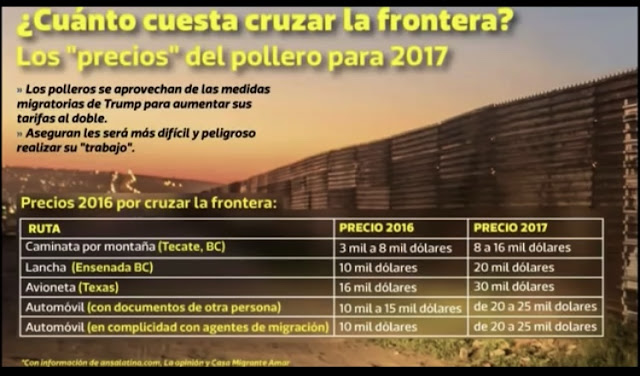https://www.princetonpolicy.com/illegalimmigration
Report: Illegal immigrant population inside US surged 550,000 in 2019
The illegal immigrant population that entered the United States from the southwest border region jumped 550,000 this year, a combination of those who crossed the U.S.-Mexico border undetected and those released into the country after being apprehended at key border crossings, according to a new report.
The numbers break down this way:
- Approximately 350,000 children traveling alone and adults with children were likely released into the U.S.
- Approximately 200,000 crossed the border undetected.
“The 'illegal' population of the U.S. (if we include asylum seekers in that group) will have increased by 550,000 in FY 2019,” according to immigration analyst Steven Kopits, president of Princeton Policy Advisors.
In his analysis, Kopits used the historical averages for illegal immigrants let into the country while their claims for asylum and other freedoms work through the legal system.
President Trump has promised to cut illegal immigration but has been thwarted in part by slow construction of a new border wall and judicial challenges to his get-tough policies.
However, Kopits noted that the administration’s diplomatic agreement to get Mexico to hold immigrants seeking to cross the border is working. He noted that some 50,000 immigrants were deported to holding areas in Mexico.
Still, the added 550,000 he estimated now in the country is more than half the 850,000 apprehended at the U.S. border in fiscal 2019.
His report said, “Approximately 852,000 persons were apprehended entering the U.S. southwest border illegally in FY 2019. Of these, roughly 550,000 were children traveling alone or children and adults in family groups. News reports indicate that approximately 50,000 of this group were deported to holding camps in Mexico under the Migrant Protection Protocol. Of those remaining in the U.S., we estimate that 70% were released into the U.S. interior pending status hearings, for example, the adjudication of asylum claims. We have been unable to find actual release rates from CBP, thus this number could be low or high and is subject to delays from time of apprehension to release."
UPDATED NUMBERS BY CBP DIRECTOR DURING A HOUSE OVERSIGHT COMMITTEE HEARING 7/19/19
900,000 IMMIGRATION COURTS BACKLOG
350,000 ASYLUM CASES
During the budget year for 2009, there were 35,811 asylum claims,
8,384 were granted (23% granted)
During 2018 budget year, there were
162,060 claims filed, and
13,168 were granted (.8% granted)
Reversing decades of U.S. policy, the Trump administration said Monday it will end all asylum protections for most migrants who arrive at the U.S.-Mexico border — the president’s most forceful attempt to block asylum claims and slash the number of people seeking refuge in America.
The new rule, expected to go into effect Tuesday, would cover countless would-be refugees, many of them fleeing violence and poverty in Central America. It is certain to face legal challenges.
Reversing decades of U.S. policy, the Trump administration said Monday it will end all asylum protections for most migrants who arrive at the U.S.-Mexico border — the president’s most forceful attempt to block asylum claims and slash the number of people seeking refuge in America.
The new rule, expected to go into effect Tuesday, would cover countless would-be refugees, many of them fleeing violence and poverty in Central America. It is certain to face legal challenges.
According to the plan published in the Federal Register , migrants who pass through another country — in this case, Mexico — on their way to the U.S. will be ineligible for asylum. The rule also applies to children who have crossed the border alone.
The vast majority of people affected by the rule are from Central America. But sometimes migrants from Africa , Cuba or Haiti and other countries try to come through the U.S.-Mexico border, as well.
There are some exceptions, including for victims of human trafficking and asylum-seekers who were denied protection in another country. If the country the migrant passed through did not sign one of the major international treaties governing how refugees are managed (though most Western countries signed them) a migrant could still apply for U.S. asylum.
Mexican Foreign Relations Secretary Marcelo Ebrard said Monday that his country “does not agree with any measure that limits access to asylum.” Mexico’s asylum system is also currently overwhelmed.
Trump administration officials say the changes are meant to close the gap between the initial asylum screening that most people pass and the final decision on asylum that most people do not win.
Attorney General William Barr said that the United States is “a generous country but is being completely overwhelmed” by the burdens associated with apprehending and processing hundreds of thousands of migrants at the southern border.
He also said the rule is aimed at “economic migrants” and “those who seek to exploit our asylum system to obtain entry to the United States.”
But immigrant rights groups, religious leaders and humanitarian groups have said the Republican administration’s policies amount to a cruel effort to keep immigrants out of the country. Guatemala, Honduras and El Salvador are poor countries, often wracked by violence.
“This is yet another move to turn refugees with well-founded fears of persecution back to places where their lives are in danger — in fact the rule would deny asylum to refugees who do not apply for asylum in countries where they are in peril,” said Eleanor Acer of Human Rights First.
ACLU attorney Lee Gelernt, who has litigated some of the major challenges to the Trump administration’s immigration policies, said the rule was unlawful and the group planned to sue.
“The rule, if upheld, would effectively eliminate asylum for those at the southern border,” he said. “But it is patently unlawful.”
U.S. law allows refugees to request asylum when they arrive at the U.S. regardless of how they arrive or cross. The crucial exception is for those who have come through a country considered to be “safe,” but the Immigration and Nationality Act, which governs asylum law, is vague on how a country is determined safe. It says pursuant to a bilateral or multilateral agreement.”
Right now, the U.S. has such an agreement, known as a “safe third country,” only with Canada.
Mexico and Central American countries have been considering a regional compact on the issue, but nothing has been decided. Guatemalan officials were expected in Washington on Monday, but apparently a meeting between Trump and Guatemalan President Jimmy Morales was canceled amid a court challenge in Guatemala over whether the country could agree to a safe-country agreement with the U.S.
The new rule also will apply to the initial asylum screening, known as a “credible fear” interview, at which migrants must prove they have credible fears of returning to their home country. It applies to migrants who are arriving to the U.S., not those who are already in the country.
Acting Homeland Security Secretary Kevin McAleenan said additional funding given by Congress for aid at the U.S.-Mexico border isn’t enough.
“Until Congress can act, this interim rule will help reduce a major ‘pull’ factor driving irregular migration to the United States.”
The treaties that countries must have signed according to the new rule are the 1951 Convention relating to the Status of Refugees, the 1967 Protocol or the Convention against Torture and Other Cruel, Inhuman or Degrading Treatment or Punishment. But, for example, while Australia, France and Brazil have signed those treaties, so have Afghanistan and Libya, places the U.S. does not consider safe.
Along with the administration’s recent effort to send asylum seekers back over the border , Trump has tried to deny asylum to anyone crossing the borderillegally and restrict who can claim asylum, and the attorney general recently tried to keep thousands of asylum seekers detained while their cases play out.
Nearly all of those efforts have been blocked by courts.
Tens of thousands of Central American migrant families cross the border each month, many claiming asylum. Border facilities have been dangerously cramped and crowded well beyond capacity. The Department of Homeland Security’s watchdog found fetid, filthy conditions for many children. And lawmakers who traveled there recently decried conditions .
But many migrants say they are simply too scared to stay in their own countries.
Oscar Ponce, a 48-year-old bus driver from Honduras who was waiting in a Mexican border town to cross into the U.S., said he wanted to apply for asylum legally. He left his home after gangs threatened to kill him if he didn’t pay their “tax.”
“Plan B is through the river,” Ponce told The Associated Press in Ciudad Juarez.
Immigration courts are backlogged by more than 800,000 cases, meaning many people won’t have their asylum claims heard for years despite more judges being hired.
People are generally eligible for asylum in the U.S. if they fear return to their home country because they would be persecuted based on race, religion, nationality or membership in a particular social group.
During the budget year for 2009, there were 35,811 asylum claims, and 8,384 were granted. During 2018 budget year, there were 162,060 claims filed, and 13,168 were granted.
Immigration and Customs Enforcement agents are preparing to conduct raids beginning Sunday (7/14/19) to arrest thousands of illegal immigrants across the U.S. just weeks after President Trump announced that he was delaying the operation.
The ICE agents will target at least 2,000 immigrants whose deportations have already been ordered
“What we believe is happening is Veronica Escobar’s office is going … to basically second-guess and obstruct work already done by the Border Patrol,” a union official told the Washington Examiner. (RELATED: Mexico Overwhelmed As It Takes On More Illegal Immigrants)
The loophole exists because the “Remain in Mexico” policy requires returned migrants to be fluent in Spanish while they stay in that country for up to five years pending a U.S. judge’s asylum claim decision.
CBP officials told the Washington Examiner that Escobar’s aides are “reescorting people back to the port” and “telling officers the Central American individual with them cannot speak Spanish despite their having communicated in it days earlier.”
“What we’re hearing from management is that they’re attempting to return people, and the story was changed in Mexico, where a person who understood Spanish before now doesn’t understand — where a person who didn’t have any health issues before now has health issues,” the union representative told the Examiner.










No comments:
Post a Comment